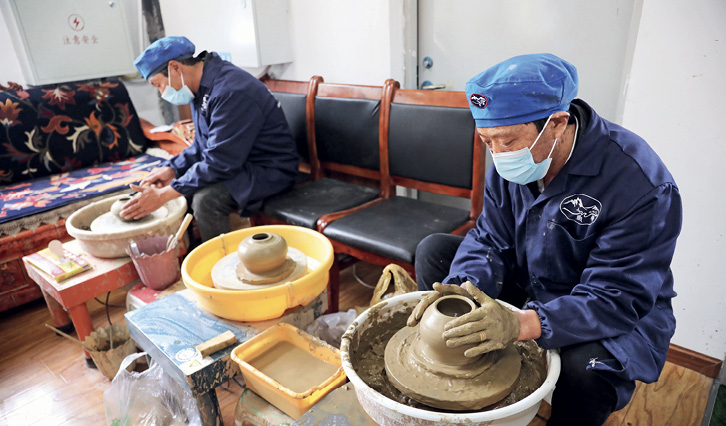Thriving on Tradition

Supportive policies and generational skills change lives in remote villages of Xizang.
Nagqu, the city with the highest average altitude in China and a gateway to Xizang Autonomous Region, is an important transportation hub along two national highways. It is also a focus of the local government’s rural revitalization drive to improve the lives of local residents, who are mostly farmers and herdsmen, by promoting traditional crafts and establishing local brands.
The Zanba Cooperative in Qurongduo, a village in Nagqu, is a prime example of that. It is a designated brand store, selling Tibetan-style bags, curtains and ethnic handicrafts. In addition to selling its products in the store, the cooperative also sells them in the neighborhood through exhibitions and themed events. With the support of local government, e-commerce and logistics companies joined force to help the local specialties reach consumers across the country.
Today, the cooperative’s annual net income is more than RMB 120,000, and the dividends are distributed among nearly 600 villagers. Besides, it provides jobs for four locals. Yangga, a 35-year-old villager, is one of them. She said the job brings her about RMB 3,000 a month and also leaves her time to take care of her children.
The Chusang Farmers and Herdsmen Professional Cooperative is another initiative providing a platform for traditional craft. Ninang, the village where the cooperative is located, is known for its time-honored pottery-making technique. For generations, families have been making the distinctive pottery of the plateau. Then in 2015, to boost the local economy and promote cultural inheritance, six villagers established the cooperative.
“There were numerous difficulties at first,” said Dazu, head of the cooperative and one of the founders. Getting funding was one of them. “We raised the startup capital by collecting RMB 20,000 from each household in the village. But though the cooperative was finally set up, due to our remote location and the erratic quality of our products, we could not make any money. Also, no one had heard of us.”
So, the cooperative asked senior artisans to help. They taught the artisans how to improve the raw material, and refine the technique and supervised the entire pottery making process. Under their supervision, the product quality improved. Next came the challenge of raising the profile of the obscure cooperative. From 2022, it started taking part in exhibitions and themed events and today, has made a name for its traditional handmade pottery. In 2022, the pottery of Ninang was listed as a city-level intangible cultural heritage item.

The nearly 80 households in the village are all involved in making pottery, with an efficient division of labor. Some get the clay, some are in charge of sales, and the rest are the potters.
The cooperative is also making modern pottery items for daily use along with traditional items. The production depends on the orders they get. Currently, the cooperative’s annual income is more than RMB 400,000, with the income from pottery products alone around RMB 160,000. It has been able to repay the money collected from each household during its early fund-raising days, and also pays them an annual dividend of RMB 6,000 on average. This has improved the villagers’ income and promotes the traditional craftsmanship as well.
The Jinzhen Yinxiu Tibetan Art Store, displaying various styles of Tibetan clothes on its two floors, is an individual entrepreneurial venture. The owner Buga comes from a family that has made Tibetan clothing for generations. He himself began sewing as a child. So, it was no surprise that he would eventually open his own store. What was surprising was the meager number of customers the store received when it opened and Buga struggled to pay the rent. There were many times when he thought of giving up.
But 2022 was a turning point. He participated in a sewing competition during a themed event and came first in the county-level competition. He then took part in the next round and was second in the city-level contest. His exquisite craftsmanship gained recognition and his store started receiving attention. Today, his average annual income is more than RMB 2 million.
With improved brand awareness, the little store has expanded from the original 30 square meters to the present impressive 200-square-meter two-storied building. Its production capacity has also significantly increased, making about 40 pieces of clothing daily. In addition to local sales, his clothes are sold in neighboring areas.
“In the past, the future of traditional handicrafts did not look promising and the younger generation showed little interest in them,” Buga said. But the supportive policies of the local handicrafts and the themed events have changed the scenario.
The number of his apprentices has also increased from the initial six to 18, and they earn between RMB 3,000 and 8,000 per month. Ten of his former apprentices, after they finished their stint at the store, have opened their own stores, which are doing well. Buga regards it as a rise in the cultural influence of Tibetan clothes and culture. “Tibetan-style sewing is a traditional skill passed down by our elders. My goal is to promote this skill,” he said. 
 Facebook
Facebook
 Twitter
Twitter
 Linkedin
Linkedin
 Google +
Google +










